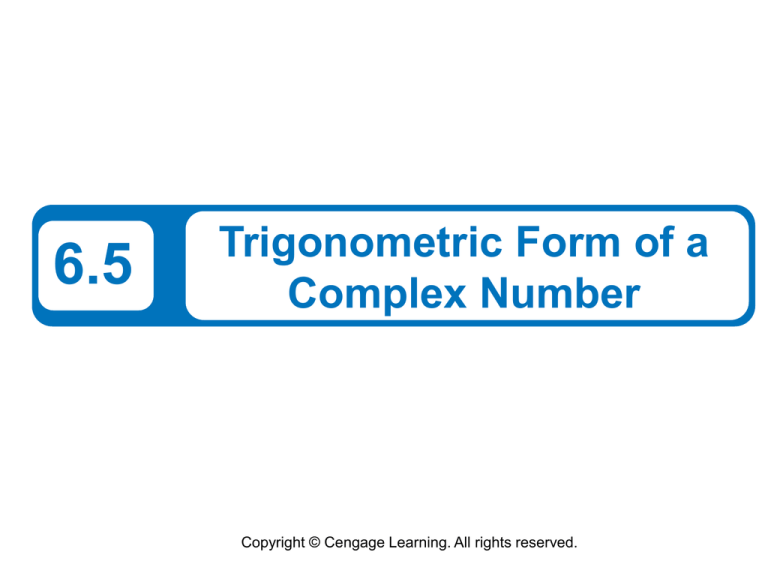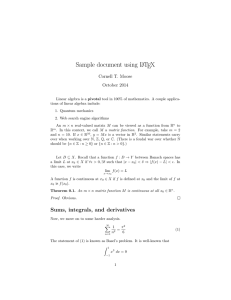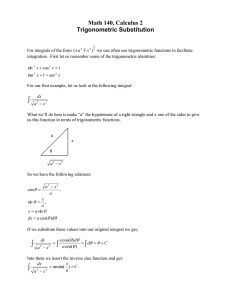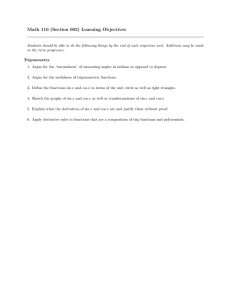
6.5
Trigonometric Form of a
Complex Number
Copyright © Cengage Learning. All rights reserved.
What You Should Learn
•
•
•
•
Plot complex numbers in the complex plane and
find absolute values of complex numbers.
Write trigonometric forms of complex numbers.
Multiply and divide complex numbers written in
trigonometric form.
Use DeMoivre’s Theorem to find powers of
complex numbers.
2
The Complex Plane
3
The Complex Plane
Just as real numbers can be represented by points on the
real number line, you can represent a complex number
z = a + bi as the point (a, b) in a coordinate plane (the
complex plane).
The horizontal axis is called the
real axis and the vertical axis is
called the imaginary axis, as
shown in Figure 6.47.
Figure 6.47
4
The Complex Plane
The absolute value of a complex number a + bi is
defined as the distance between the origin (0, 0) and the
point (a, b).
5
The Complex Plane
When the complex number a + bi is a real number (that is,
when b = 0), this definition agrees with that given for the
absolute value of a real number
|a + 0i| =
= |a|.
6
Example 1 – Finding the Absolute Value of a Complex Number
Plot z = –2 + 5i and find its absolute value.
Solution:
The complex number z = –2 + 5i is plotted in Figure 6.48.
The absolute value of z is
|z| =
=
Figure 6.48
7
Trigonometric Form of a Complex Number
8
Trigonometric Form of a Complex Number
To work effectively with powers and roots of complex
numbers, it is helpful to write complex numbers in
trigonometric form.
In Figure 6.49, consider the
nonzero complex number
a + bi.
Figure 6.49
9
Trigonometric Form of a Complex Number
By letting be the angle from the positive real axis
(measured counterclockwise) to the line segment
connecting the origin and the point (a, b) you can write
a = r cos
and
b = r sin
where
r=
Consequently, you have
a + bi = (r cos ) + (r sin )i
from which you can obtain the trigonometric form of a
complex number.
10
Trigonometric Form of a Complex Number
11
Example 2 – Writing a Complex Number in Trigonometric Form
Write the complex number z = –2i in trigonometric form.
Solution:
The absolute value of z is
r = | –2i|
= 2.
12
Example 2 – Solution
cont’d
With a = 0, you cannot use tan = b/a to find . Because
z = –2i lies on the negative imaginary axis
(see Figure 6.50), choose = 3 /2.
So, the trigonometric form is
z = r(cos + i sin )
Figure 6.50
13
Example 4 – Writing a Complex Number in Standard Form
Write the complex number in standard form a + bi.
Solution:
Because cos(–/3) =
write
and sin(–/3) = –
, you can
z=
14
Example 4 – Solution
cont’d
15
Multiplication and Division of
Complex Numbers
16
Multiplication and Division of Complex Numbers
The trigonometric form adapts nicely to multiplication and
division of complex numbers.
Suppose you are given two complex numbers
z1 = r1(cos 1 + i sin 1)
and
z2 = r2(cos 2 + i sin 2)
17
Multiplication and Division of Complex Numbers
The product of z1 and z2 is
z1z2 = r1r2(cos 1 + i sin 1)(cos 2 + i sin 2)
= r1r2 [(cos 1 cos 2 – sin 1 sin 2)
+ i(sin 1 cos 2 + cos 1 sin 2)]
= r1r2 [(cos (1 + 2) + i sin(1 + 2)].
Sum and difference
formulas
18
Multiplication and Division of Complex Numbers
19
Example 5 – Multiplying Complex Numbers in Trigonometric Form
Find the product z1z2 of the complex numbers.
Solution:
20
Example 5 – Solution
cont’d
= 6(cos + i sin )
= 6[–1 + i(0)]
= –6
The numbers z1,z2 and z1z2
are plotted in Figure 6.52.
Figure 6.52
21
Powers of Complex Numbers
22
Powers of Complex Numbers
The trigonometric form of a complex number is used to
raise a complex number to a power. To accomplish this,
consider repeated use of the multiplication rule.
Read this slide and the next, but do not copy.
z = r(cos + i sin )
z2 = r(cos + i sin ) r(cos + i sin )
= r2 (cos 2 + i sin 2 )
z3 = r2 (cos 2 + i sin 2 )r (cos + i sin )
= r3(cos 3 + i sin 3 )
23
Powers of Complex Numbers
z4 = r 4(cos 4 + i sin 4 )
z5 = r 5(cos 5 + i sin 5 )
.
.
.
This pattern leads to DeMoivre’s Theorem, which is
named after the French mathematician Abraham DeMoivre
(1667–1754).
24
Powers of Complex Numbers
25
Example 8 – Finding a Power of a Complex Number
Use DeMoivre’s Theorem to find
Solution:
First convert the complex number to trigonometric form
using previous formulas for r and theta:
r=
=2
and
= arctan
26
Example 8 – Solution
cont’d
So, the trigonometric form is
Then, by DeMoivre’s Theorem, you have
(1 +
i)12
27
Example 8 – Solution
cont’d
= 4096(cos 4 + i sin 4)
= 4096(1 + 0)
= 4096.
28






